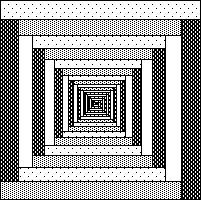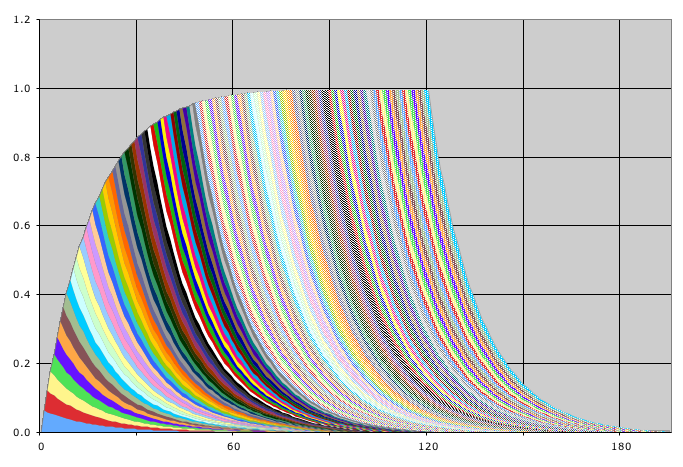Introduction
In the prior article we discussed Work in the Living Algorithm System. We casually introduced the notion of energy and its relation to work. We noted that energy could be employed actively as kinetic energy, or stored as potential energy. We suggested that this analysis applied to both material systems and the Living Algorithm's Information System. To provide the necessary foundations for our structure, let’s discuss information energy in more detail.
Questions
Information energy? What could this possibly mean? Doesn’t energy require a physical component – some atoms and molecules bouncing around exchanging momentum? How could non-material information have energy? To provide context, let us first talk a little about physical energy, not what it is, but its significance for humans.
The Importance of the Notion of Energy
Galileo’s experiments indicate that universal laws of motion exist.
Galileo’s experiments illustrated that all balls regardless of size or weight moved with a constant and identical acceleration when rolling down an inclined plane. This indicated that objects do not have a motive force of their own, but instead obeyed some type of universal laws related to dynamics. This revelation opened the door to an investigation of first, what those universal laws are, and second, how to manipulate these laws to human advantage.
Newton reveals Universal Laws of Motion.
Although Descartes, Aristotle and many others had speculated about the nature of these universal laws, Newton’s laws of motion had an abundance of experimental data to support his propositions, as well as a firm mathematical foundation. Indeed the experimental verification and refinement of Newton’s laws became a major scientific preoccupation.
“For at least a century after the publication of [Newton’s] Principia, calculations of the motions of the planets remained the most important application and confirmation of both Newton’s laws of mechanics and his law of gravity.” (Physics for Poets, p.65)
Notion of Energy required to manipulate universal laws for human advantage.
Newton accurately articulated the universal laws of motion, but he did not provide the insight as to how to manipulate these laws for human advantage. It was only in the Industrial Revolution of the 19th century that humans were able to take the next step. This had to do with the concept of energy.
“Man’s conquest of his material environment can be written as the story of the mastery of energy.” (Physics for Poets, p. 67)
In somewhat similar fashion, the manipulation of information energy is required to better manipulate our psychological environment to our advantage. To manipulate this energy we must first know what it is and believe that it even exists.
Current Scientific Mindset on Energy
Energy and Dynamics are inextricably linked. As such, information energy is at the foundation of Information Dynamics, which is based in the Living Algorithm’s method of digesting information. In prior papers we have spoken of info energy in loose terms - just as a way of conveying meaning without scientific precision. It's essential that we tighten up our definitions to provide for greater clarity and understanding.
Traditional Energy is Physical
The notion of info energy raises some perplexing questions relative to traditional uses of the word 'energy'. We can think of thermodynamic energy as heat, which we experience when we sit in front of a campfire, or when we turn our thermostat on. This energy, in turn, translates into the motion of molecules and chemical interactions. Wind and water energy move machines to do work. And nuclear energy, via Einstein's E=mc2, is the translation of the mass of a hydrogen atom into energy to drive our power plants, which, in turn provide us with the electric energy that is so essential to our modern culture. Each of these types of energy is based in the physical world, complete with a cogent scientific physical explanation. In fact, the insights of scientists have allowed us to tap into these energy reservoirs.
No Energy in Traditional Information Theory – just Redundancy for Accuracy
So how can information possess energy, seeing as how it has no physical component? Further, isn't information neutral?
In fact, there is no notion of energy in the traditional information theory developed by Shannon in the 1950s. His theory is at the heart of electronic information processing. The aim of traditional information theory is accuracy of transmission. As such, this branch of information theory focuses upon redundancy. Redundancy ensures exact replication of electronic signals from one place to another - whether from the TV station to our homes, or from the satellites to our I-Phones and computers. Researchers have applied redundancy reasoning to living systems, as well. The most notable example is the double helix of DNA/RNA genetics fame. It’s obvious that Shannon’s information theory has proved to be a powerful explanatory model.
Current scientific mindset: Energy has Physical Basis, Information has no Energy
The current view of contemporary scientists regarding energy is straightforward. Energy has a physical component and because information is not physical, it does not possess energy. This mindset has transformed how we interact with our world in ways beyond imagining. These notions of energy have provided us with both physical energy to run our world and exact information transmission to accurately communicate via computers and the Internet.
Must view energy in a new way to understand Life's dynamic nature
The dynamic nature of living systems, especially human behavior, remains inscrutable to this powerful mindset. To deal with living systems we propose another way of thinking about energy. We suggest that energy does not require a physical basis and that information can possess energy. This notion challenges the two aforementioned powerful mindsets of our contemporary world. It requires that we expand our notion of energy. This does not mean that we are going to create a new definition of energy. We are just going to distill the current notion of energy to extract its core essence.
Info Energy in the Living Algorithm System
“The great discovery of the nineteenth century was that whenever energy disappears there is some observable change in the world, and by patient study this change can be quantitatively related to the amount of energy lost.” (Physics of Poets, p 75)
Energy has the ability to transform the state of a System
A key feature of energy is its ability to transform the state of a system. For example, fossil fuels, such as oil, are a source of stored energy. After converted into a useable form this gooey black stuff drives our global economy – transforming that system in myriad ways, such as powering our vehicles. Electrical energy changes the state of our TVs and computers. Heat energy changes the state of our bodies by making us warm, and human energy transforms the state of the world. These are just a few examples.
Living Algorithm's Information System
Energy belongs to the system it changes. The mathematics associated with the Living Algorithm describes an energetic system. In fact, as we have discussed, it has many similarities with the heating system of a house. For instance, both systems turn on and off; both systems store and utilize energy. Because information fuels the Living Algorithm System, we will call it an information system.
Electronic Information Processing vs. Living Algorithm's Information Digestion
Yet this information system is quite unlike the information system of electronic data processing. In electronics, exact transmission is of utmost importance – so that our Emails aren’t garbled for instance. To accomplish this we employ a machine, such as a radio or computer. In our system, the Living Algorithm is the sole vehicle that digests information. In contrast to information processing whose focus is accuracy, digesting information means translating the data into an intelligible form.
Info Energy changes the state of the Living Algorithm System
Just as a thermostat indicates the temperature of the house (its state), the Living Average is a measure of what’s going on inside the Living Algorithm System (its state). How does info energy change the Living Average? Just as oil drives our global economy, info energy drives the Living Algorithm System. Without data nothing happens. If a data stream consists solely of a string of zeros (the null string), there is no activity. The Living Average remains unchanged. However, as soon as non-zero data enters the system, the Living Algorithm engine employs this info energy to alter the Living Average. This is the essence of info energy. The prime focus of Information Dynamics is how to tap into the natural energy of information processing to change the state of our personal system. This enables us to maximize our potentials, whether for fun or productivity, through more effective use of this energy. Let's flesh out the notion of info energy.
Binary Subsystems of the Living Algorithm System
What does info energy refer to mathematically? Let's take a graphic look at these abstract concepts to give them a more concrete reality.
Triple Pulse System, a subsystem of the Living Algorithm System
The Living Algorithm System has myriad manifestations. In fact, it contains an infinite number of transformations. The Living Algorithm’s specialty is digesting data streams. These data streams can be of any length, (even unending and infinite), and the data can be any number. To simplify our exploration, we are going to restrict these parameters. In this particular study, there are 3 restrictions. 1) The data can only be ‘one’ or ‘zero’; 2) the ordered sequence must be exactly 360 data points in length; and 3) the system must start at absolute zero. The ideal Triple Pulse fits this definition. Accordingly, we shall call this Living Algorithm subsystem, the Triple Pulse System.
Binary Triple Pulse System turns On & Off
The Triple Pulse System has a strictly binary nature, as the data only consists of 'ones' and 'zeros'. As such let us consider the 'ones' as moments when the System is 'on', and the 'zeros' as moments when the System is 'off'. We could then say that the System turns 'on' long enough to generate the Active Pulse. It then turns 'off' long enough to generate the Rest Pulse. It then turns ‘on’ long enough to generate the final Active Pulse. This is visualized in the graph below.
A. The Triple Pulse & the Data Stream
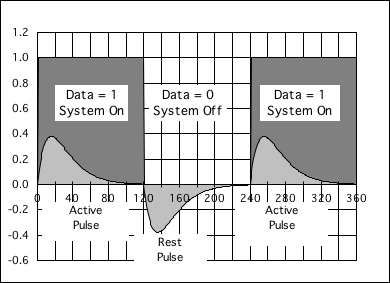
Graph: On/Off Data Stream
B. On/Off Data Stream Only
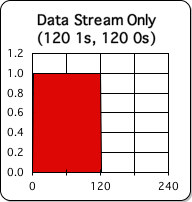
C. Data Stream & Living Average
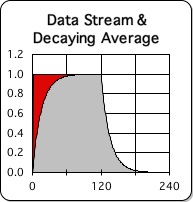
The Triple Pulse data stream consists of a string of 120 1s, 120 0s, and 120 1s. For simplicity and the purposes of illustration, let's abbreviate this data stream by cutting off the last 120 1s. For reasons that will become apparent, let us call this the On/Off data stream. This On/Off data stream is shown at the right (Graph B). It consists of a red block of ones, followed by an empty block of zeros. The System turns 'on' (the red) and then turns 'off' (nothing).
Graph: On/Off Living Average
In the process of digesting a data stream, the Living Algorithm generates a series of measures that describe the dynamics of the data stream. These measures describe the data stream’s rates of change (the derivatives) from moment-to-moment. In a prior article, we referred to these derivatives as the Living Algorithm's Family of Measures. Graph C at right represents the 1st derivative of the On/Off data stream (its Living Average). Graph A (the classic Active and Rest Pulse) is a visualization of the 2nd derivative of the Triple Pulse data stream. Both are measures of the rates of change (derivatives) of the data stream.
Living Average computed from Raw Data
The grey area in Graph B is a visualization of the Living Average. The Living Average is the only Living Algorithm Measure that is computed directly from the Raw Data; the rest of the Measures are 'derivatives' of this basic measure. This is one reason why the Living Average represents the state of the Living Algorithm System.
When System is 'on', Info energy changes State of System
When the System is 'on', the repeated employment of the Living Algorithm engine gradually changes the Living Average (the state of the System) from 0 to 1. Beginning at zero, the curve of the Living Average (the grey area) rises steeply in the beginning and then levels off as it approaches one, its ultimate limit. Because the ones (the data bits of the data stream) change the state of the Living Algorithm System, we call them bits of 'info energy'. Remember: Energy has the potential to change the state of the system it belongs to.
Data Residue = Potential Info Energy
However, not all of this info energy is employed at once. We can see this on Graph B. The red rectangle representing the string of ones (Graph A) remains beneath the grey area (the Living Average). The portion of the red rectangle that is showing is the difference between the info energy of the raw data (the string of ones) and the Living Average. We call this left over part (the red area in Graph B) the 'data residue'. The data residue is the 'potential info energy' of the Living Algorithm System.
Data Residue (Potential Energy) used up after System shuts down
When is the potential info energy of the data residue used up? The data residue begins to be consumed as soon as the System shuts down (the data stream shifts from ones to zeros). At this moment, the curve of the Living Average falls precipitously, and then levels out, as it approaches zero.
Living Algorithm System eventually consumes Data Energy completely
Note that the data residue (the red triangle) is identical in area to the portion of the Living Average that follows after the System shuts down (the triangular grey area in Graph 1). This equality is indicated visually (Pythagorean style) in the series of graphs that follow. This exhibits one of the main principles of Living Algorithm mathematics. Any data (info energy) that enters the System is eventually used up completely ('practically' speaking).
0. Living Average & Data
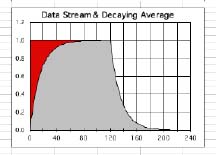
2. Rotate Left
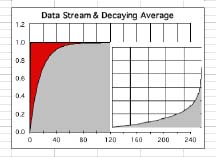
4. Horizontal Flip
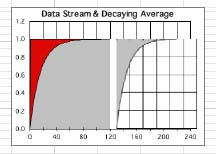
1. Break off Living Average from 0 string
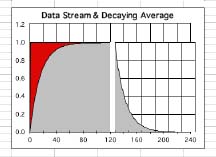
3. Rotate Left Again
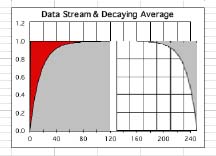
5. Superimposed on Data Residue
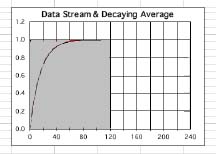
Living Algorithm digests an entire Data Bit of Info Energy
Graph: The Living Average
C: One Data Bit is consumed
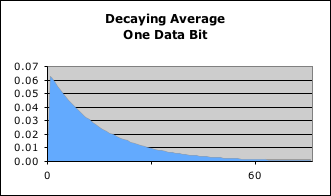
To better understand the process let us examine first hand how the Living Algorithm digests each data bit. The data bit enters the System as a snack with a value of 'one'. The Living Algorithm immediately transforms this 'one' into a fraction of itself (0.06). With each successive repetition (iteration) of the process, the Living Algorithm scales down the current value by a set percentage. After the number has been scaled down a sufficient number of times (via iteration) it approaches zero in value ('practical' zero). The graph on the right illustrates this process. This is a picture of the Living Average.
Living Algorithm spreads Data into 2 dimensions
However, not all of this info energy is employed at once. We can see this on Graph B. The red rectangle representing the string of ones (Graph A) remains beneath the grey area (the Living Average). The portion of the red rectangle that is showing is the difference between the info energy of the raw data (the string of ones) and the Living Average. We call this left over part (the red area in Graph B) the 'data residue'. The data residue is the 'potential info energy' of the Living Algorithm System.
Summation of Scaled Values equals Data
Let's take another view of the data, this time in its spiral 2 dimensional form. As each of the scaled values in the graph above is added up, the summation approaches one, the value of the data bit. This would be true no matter what value the data point is. For instance, when the Living Algorithm digests a data point of 6, the sum of the scaled values would also equal six. The square spiral at right illustrates this process. Each rectangle represents one of the scaled values in Graph C. The first increment of the digested data is the largest. The subsequent increments get smaller and smaller, spiraling ever inward. (Note that once the data enters the Cell Function, it never leaves. It just becomes a 'practical' infinitesimal.)
Graph: The Living Algorithm digests the On/Off Data Stream
The Living Algorithm digests each new piece of data that enters the System in the same fashion. To illustrate this process, we chose to see what happens when the Living Algorithm digests the On/Off Data Stream. (Remember this data stream consists of 120 1s followed by 120 0s.) The result is shown in the graph on the right. Notice the blue shape at the bottom of this graph. Graph C (the consumption of a single data bit) is an enlargement of this same portion. The red stripe on top of the blue shape illustrates what happens when the Living Algorithm digests the second 'one' in the data stream. The yellow stripe and each subsequent stripe is layered in the same fashion. With each new data bit this process is repeated (via iteration). After the final ‘one’ in the sequence the System turns off. The data stream now consists solely of 0s. Accordingly, no new info energy is added to the System. After this point, all activity is the completion of processes already under way. Each ‘one’ that entered this system prior to this point must finish off its decay cycle.

Same Living Average for a Data Stream of Ones
Both the grey graph at right and the multi-colored graph above depict the same Living Average. Notice that the shape and area of each field is identical. The multi-colored image shows the Living Average broken into her component parts. Don't think too hard. Just allow this unusual information to be assimilated via osmosis.
Matter's Conservation of Energy vs. Information's Consumption of Energy
We have stressed that energy has the ability to change the state of the system. In fact, we have suggested that this is a prime criterion for identifying energy. To support this claim we offered examples from traditional physical energetic systems: mechanical, thermodynamic and electrical. We then applied this definition to the Living Algorithm System to support the claim that hers is an energetic system based on the flow of information. However, there is a significant point of departure between the 2 aforementioned systems - one matter-based and the other information-based. In material systems energy is conserved. In fact the conservation of energy is one of the fundamental laws of thermodynamics. Einstein's famous equation (E = mc2) even links matter into the conservation package. Matter can be converted into energy and vice-versa, but there can be no net loss to the system that they belong to. As just seen, the Living Algorithm System is exactly opposite. Data stream energy is always consumed completely. None is conserved.
Living Algorithm’s System requires down-time to digest Info
In fact, we will argue in future papers that problems of overload occur if the System isn't given sufficient time to digest information. In similar fashion, if we are not given enough time to digest our food, indigestion occurs. The popular expression 'information overload' captures this concept. The Living Algorithm System digests information completely, but needs down time to finish the process. This is totally different from material systems, where the quantity of the energy/mass complex remains identical despite the myriad transformations those material systems go through.
Living Algorithm & Living Systems require Information Synergy – Material Systems do not
A final point on this topic before moving on: Our analysis has shown that energy is conserved in material systems, while energy is consumed in the Living Algorithm System. This significant difference between material systems and our information system is also a crucial criterion that distinguishes material from living systems. Living systems require an ongoing synergy of information input and digestion to survive. When biological systems cease to digest information they run down and die. This is very different from material systems, which go on forever due to the conservation of energy. In similar fashion to living systems, the Living Algorithm System also eventually runs down with no new info energy to power the system. This is yet another way in which the Living Algorithm parallels Living Systems and differs from Material Systems.
Note: the idea that energy is consumed in info systems leads to the idea that energy is a limited resource, while the idea that energy is indestructible in material systems leads to the idea that energy is an unlimited resource.

Conclusions, Questions & Links
Let's summarize our findings. The synergy between the Living Algorithm and any data stream defines an Information Processing System. The data stream is the door by which info energy enters the System. The info energy comes in the form of discrete data bytes. The Living Algorithm digests these bytes. The process of digestion transforms this data from an instantaneous point to a meaningful fact that exists through time. The Living Algorithm process spreads the 'energy' over time, scaling it by a precise percentage with each successive repetition of the digestive process. Via a graphic visualization of the Living Average we saw that when the Living Algorithm digests each byte of information, a fraction of the info energy is employed to change the state of the System, and the rest is stored as potential info energy. As long the System remains 'on' (ones), the Living Algorithm isn't able to digest all the info energy. However, when the System 'turns off' (zeros), this gives the Living Algorithm the opportunity to digest the potential energy that is left over from the 'on' cycle. A graph of the Living Average allows us to visualize this process. This process eventually consumes the information energy in its entirety. This marks a major point of departure from material systems, where energy is conserved. However, info energy consumption is a major point of congruence between biological systems and the Living Algorithm System. This similarity aligns the Living Algorithm & Life once again.
Questions & Links
As usual, these findings, while answering some questions, raise many more. We've seen that the information flow in a data stream may contain energy. But what is the relevance? What does this mean? What practical value does info energy have? Heat energy keeps us warm; gravity holds us onto the earth; and the conversion of the kinetic energy of water and wind into the electricity that drives our electronic world. What does info energy do? It certainly does not power cars or computers. Nor will it solve the global energy crisis. What does info energy consist of? And what work does it do? Why should we even care about info energy at all? To investigate these questions, check out the next article in our series – Info Power in the Living Algorithm System.
